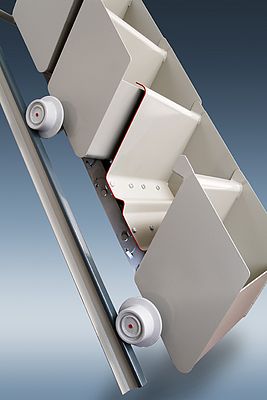AUMUND Fördertechnik GmbH, is to supply a Hot Transport Conveyor (HTC) for charging of Hot DRI directly into the EAF. At JSW Toranagallu (Karnataka Province, India) the HTC connects the Midrex DR shaft with the Electric Arc Furnace. The primary link is a sealed gas atmosphere which enables Hot DRI charging with very low loss of temperature and metallization. Compared with traditional charging methods significant energy savings and productivity increases can be expected.
The Hot Transport Conveyor (HTC) from AUMUND comprises a bucket apron conveyor type BZB-H-I 400/400 (axial distance:140m, lift: 58.5m), with heat-insulated hood and AUMUND seal gas system and drive. Delivery to India will take place in the third quarter of 2013. The conveyor is designed for the transport of HDRI up to 750°C with a conveying capacity of 165t/h.
The AUMUND HTC conveyor links the direct reduction shaft furnace, in which the iron ore is reduced to iron, with the EAF. Through the direct connection of shaft furnace and EAF, productivity of the plant can be significantly increased. The opening of the EAF hood as well as charging with traditional buckets is dispensed with. With each smelting process several minutes are saved – which is considerable given the production process has been optimized over decades.
By dispensing with the hood opening, no further heat can escape in this time period. Compared with traditional material transport in buckets or tubs, temperature loss during transport is very low with the AUMUND conveyor.
The Hot Transport Conveyor (AUMUND HTC) has been systematically optimized over the last few years with a close eye on requirements as demanded by a harsh operating environment: The significantly improved seal in the well-known buckets guarantees gentle transport under sealed gas. Thanks to the reduced ingress of false air the danger of re-oxidation tends to zero. At the same time the operator can better optimize the proportion of carbon in the iron and as a result the metallization can be enhanced. The improved heat insulation leads to heat loss reduction during material transport. In the described case study the advantages of a hot material conveyor can be seen: All kinds of HDRI can be transported, ranging from very fine-grained material to very lumpy material. As there is no relative movement during transport in contrast to that of pneumatic conveyors, no additional fines are generated. The AUMUND Hot Transport Conveyor (AUMUND HTC) can be employed in any location where a direct link between direct reduction and EAF is possible.
Since the end of the 90’s direct reduction has gained increased significance as the process employed to produce pig iron from iron ore, to the exclusion of the traditional blast-furnace process. The - as a rule - direct proximity of pig iron production to steelworks offers a range of economic advantages: At the end of direct reduction the pig iron exhibits a high degree of metallization in solid form either as a bulk material (fines or lumpy), as a briquette (HBI) or compacted as non- uniform disks/plates (HCI). The hot DRI can be forwarded immediately for further processing in the steelworks. At JSW the bucket apron conveyor transports the hot DRI from the shaft furnace to the steel plant.
Similar conveying installations were also supplied to, among others, Posco (Korea) and Hadeed (Saudi Arabia), further installations are at the planning stage.
Hot Transport Conveyor
saves energy and increses productivity
- by AUMUND Fördertechnik GmbH
- September 23, 2013
- 953 views

















